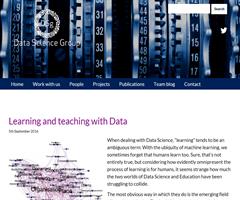Cargando ...
Learning and teaching with Data
14/09/2016

When dealing with Data Science, “learning” tends to be an ambiguous term: With the ubiquity of machine learning, we sometimes forget that humans learn too. Sure, that’s not entirely true, but considering how evidently omnipresent the process of learning is for humans, it seems strange how much the two worlds of Data Science and Education have been struggling to collide.
The most obvious way in which they do is the emerging field of learning analytics. The basic idea here is, through data analytics, to try to understand how we learn and to improve how we teach. Right now, most approaches remain technically straightforward as they focus essentially on the organisational, policy and pedagogical implications. For example, the OU Analyse system, as many others, apply predictive analytics on data extracted from university systems about the students and their learning activities, to try to forecast whether or not they will succeed.
One of the issues with this kind of approaches however is that they rely on systems which are closed, and where, almost surprisingly, sharing data is not common. In other words, many learning analytics projects have to run in isolation, having only available the data from the institution running them (if they are lucky). Of course, as in many other areas, a lot of effort has been spent to open up data from education (see the recently published book “Open Data for Education“). This remains however limited since the problem is not only that educational institutions are not sharing their data, but also that nowadays, learning happens very much outside of those institutions, and certainly not in a way that can be completely understood through the data they capture.
That is the reason why the AFEL (analytics for everyday learning) project is bringing together the area of learning analytics with social network analysis, open data, semantic web and cognitive psychology, in an attempt to understand learning as it happens ubiquitously online. Through collecting data about all online activities of a learner and about the resources they rely on, we can obtain a more complete view of their objectives, trajectories and progress. Of course, this is not without challenges, but the hope is that by showing people how they learn on the Web, we can help them become better at using the Web for learning.
Autores:
Etiquetas:
Licencia:
- Se respeta la licencia original del recurso.
